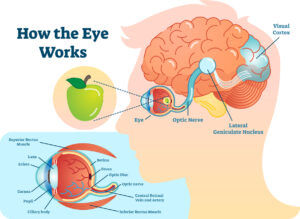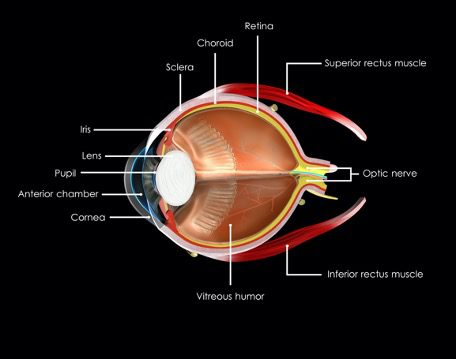The eye is an organ that grants us the ability to detect light and process visual information. A deceptively intricate piece of machinery, the eye is composed of many tiny parts working in conjunction to bring objects into focus and send sensory data to the brain. As an unfortunate byproduct of its complexity and moving parts, though, the eye is delicate. There are an array of conditions that can threaten the eye with vision loss. To maintain your vision, it’s important to practice good overall health and go in for regular eye exams.
Different Parts of the Eye
- The iris is the pigmented ring in the center of the eye—what is referred to when speaking of eye color. The iris can be any shade of brown, hazel, green, or blue.
- The pupil is the black circle in the middle of the eye. You will notice it contracts and expands to control how much light gets through.
- The sclera is the white part of the eye that surrounds the iris.
- The cornea is a clear layer that sheathes the eye. Collagen and water are responsible for the composition of this part of the eye. Tears protect the cornea by keeping it lubricated and healthy.
- The lens sits behind the pupil to focus the light coming in and direct it to the back of the eye.
- The retina is a collection of photoreceptor cells that layer the back of the eye. As part of the nervous system, the retina detects light and converts these electromagnetic waves into neural signals. The two kinds of photoreceptors in the retina are the rods and cones. Rods detect low light whereas cones detect color.
- The macula is a small area in the retina, which helps the eye register color and fine details.
- The optic nerve is located behind the retina. This nerve is responsible for carrying signals from the retina to the brain where they can be interpreted.
The eye also includes various muscles that control its movement and position as well as how much light gets into it. These muscles and the lens essentially dictate the ability of the eye to focus.
Vitreous is a transparent gel coats that the eye thereby protecting its shape.
What Does an Eye Look Like?
The shape of the eye resembles a ball that has been slightly compressed. It doesn’t quite look like a perfect sphere as it protrudes in the front. The color of the iris depends on genes and can vary between all shades of brown, amber, green, and blue. The iris can feature multiple smaller accent colors within, thanks to pigmented stripes or flecks. In some instances, there is a dark ring about the iris.
How the Eye Works
The various parts of the eye work together to send visual data to the brain which then grants the ability to see. The entire process takes about 13 milliseconds to complete.
Light enters the eye through the cornea and then goes through the lens. The pupil gets smaller or larger to control the amount of light that gets into the eye. The lens and cornea refract and bend the light to help what you are seeing come into focus. The light then reaches the retina at the back of the eye and the retina changes the images into signals or electrical impulses. The optic nerve will then transfer the signals to the section of the brain that is responsible for vision. The optic nerve carries the signals from both eyes at the same time. The brain then interprets the visuals, using the combined information from both eyes to present a singular, decodable image.
You can compare how the eye works to a camera. The shutter of a camera opens or closes depending on how much light is needed to expose the film in the back. The eye works the same way with the pupil and iris controlling the amount of light. If it is dark then the pupils are going to get larger, letting in more light. The lens of the eye, like that of the camera, helps it to focus. For those whose’ lenses are impaired and unable to properly focus, glasses or contact lenses may be needed.

Conditions That Can Affect How the Eye Works
What conditions affect how the eye works and by extension your vision?
Eyes change as the body ages. There are specific changes to vision that are contiguous with age. Some people get flashers or floaters. Others develop macular degeneration, detached retina, or cataracts as they get older.
- Various forms of cancers upon afflicting the eye can change vision.
- Conditions such as glaucoma, cataracts, birth defects, and optic atrophy are among the most common illnesses to affect sight. Optic neuritis causes inflammation in the optic nerve while other diseases specifically target the cornea.
- Infections like blepharitis or pink eye can cause discomfort, swelling, or redness. Watery eyes are usually an indicator that the tears aren’t draining properly.
- Some inherited disorders, such as retinitis pigmentosa, can lead to blindness.
- Certain injuries can cause trauma to the eye leading to detached retinas or corneal abrasions. Accidents can lead to burns, irritation, black eyes, or bleeding. Foreign objects to the eye are especially damaging.
- Problems with the muscles of the eye can change how it appears. If the change is significant, it can degenerate into changes in vision.
- Problems such as farsightedness or astigmatism affect how the eye bends light and brings an image into focus. Color blindness makes it harder to see certain colors. Certain vision problems make it harder to see at night. Conversion insufficiency disrupts the eyes’ ability to combine dual images into a collective one.
While many conditions affect the eyes directly, there are others—disorders and diseases—that start in other parts of the body and then lead to problems in the eye. These conditions include but are not limited to diabetes, autoimmune disorders like thyroid eye disease or lupus, and cardiovascular illnesses such as high cholesterol or high blood pressure. This is why it’s so important to make sure you are in optimal health in addition to getting regular vision exams.
Common Signs of Eye Problems
Some eye conditions slowly change how the eye functions, and you may not notice the issues for a while. If, however, you are experiencing any of the following symptoms consider speaking with a doctor.
- Eye redness, swelling, or pain
- Eyes that point in different directions or cross
- Squinting and headaches
- Inability to close or open eyelids or move eyes
- Flashes of light
- Very dry eyes, burning, itching, or stinging
- Dark spots in the middle of your field of vision
- Trouble seeing in low light or sensitivity to light
- Vision changes that include double vision, cloudy vision, or blurry vision
A licensed expert can perform the necessary tests to determine exactly what afflicts your eye and the means of mitigating such conditions.
Visit Florida Eye Specialists & Cataract Institute
Don’t let vision problems stand in the way of living your life. The eye is a complex organ, and all the parts need to be functioning correctly to make sure you are seeing at your very best. If you notice any issues with your eye or vision, please don’t delay care. The experts at Florida Eye Specialists & Cataract Institute can help diagnose issues with the various parts of the eye and help you get treatment. Contact us to schedule an eye exam today.



